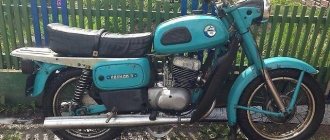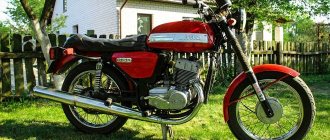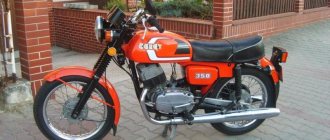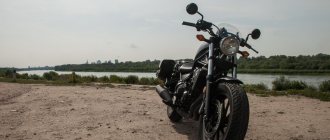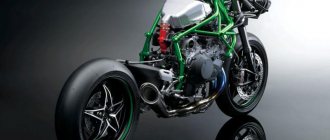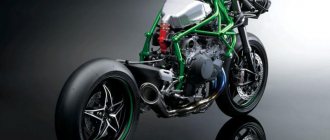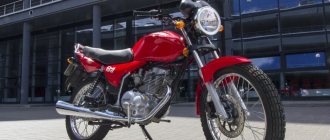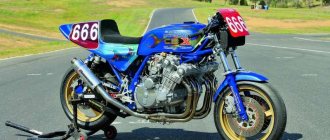DKW RT 125 1952
B RT 125
was a German two-stroke motorcycle made by DKW in Zschopau in the 1930s IF and in the 1950s and early 1960s and by DKW in Ingolstadt in the 1950s and 1960s. "RT" stands for "Reichstyp" or "National Model".
In the 1930s, DKW pioneered the Schnürle push-pull loop cleaning process, dispensing with the use of a deflector piston and increasing combustion chamber efficiency. DKW has also developed a highly efficient transfer port layout. These two features were included in the RT 125 with great commercial advantage. Competitors such as Adler and TWN copied the introduction of flat top pistons and sought to develop similar transfer port designs without violating DKW regulations. patent.
DKW RT 125-1 of the Wehrmacht, produced from 1943 to 1944
0
See all photos in the gallery
In 1922, Hermann Weber began his engineering work at the DKW plant in the city of Czopau. He was engaged in the design of motorcycles and was appointed chief designer of the plant. His first model was the light motorcycle DKW ZL (Zschopauer Leichtmotorrad). Weber also headed the DKW racing motorcycle department; in addition, he himself took part in sports motorcycle racing and was a repeated winner of a number of prestigious competitions. In 1932, DKW acquired a license from Adolf Schnürle for the method of loop purging of the cylinder of a two-stroke engine and the exclusive right to use it in gasoline engines. This patent was not used for two years until Weber designed a 97 cc engine. see power 2.5 hp for a motorcycle called RT-100. The engine was very successful and powerful for its cubic capacity. The new method of cylinder purging, successfully applied by Weber, made it possible to abandon the use of a deflector on the piston, increasing the efficiency of fuel combustion and engine power. Hermann Weber was the first to use a foot-operated gear shift on a motorcycle engine. The next motorcycle model is RT -125 with a 125 cc engine. see created by Weber in 1939, became revolutionary in the history of motorcycles. The DKW RT-125 model was the most copied motorcycle in the world; it was produced in different countries from 1940 to 1965. After the end of World War II, the city of Cshopau found itself in the zone of Soviet occupation. The DKW plant was dismantled and taken to the USSR as reparations. Herman Weber and a number of other plant workers were interned and sent to Izhevsk to set up production of the IZH-350 motorcycle (copies of the DKW NZ 350). In 1948, Hermann Weber died in Izhevsk.
2.
Model history
DKW RT 125 DKW RT 125-1 of the Wehrmacht, produced from 1943 to 1944
Civil models
In 1930, DKW pioneered the use of a purge cycle for two-stroke engines, which eliminated the use of a piston deflector and increased combustion efficiency.
The 1939 RT 125 motorcycle was based on the 1934 RT 100, which was known as the RT 2.5 L. With. This bike was a sensation in the 100cc class. The cost of the 1934 RT 100 motorcycle was only 345 Reichsmarks. The 1939 RT 125 cost 425 Reichsmarks and was only available in black.
Wehrmacht models
In 1941, the RT 125 was put into service with the German Wehrmacht in large quantities.
In 1943, a slightly modified version for the military was released called RT 125-1, also known as RT 125 nA (RT 125 neuere Ausführung - new version). Among the changes in the RT 125-1 are large tanks with a military tank cap, a vortex air filter, an engine made entirely of cast iron, and dark yellow or olive-colored paint. The motorcycle was very light (empty weight 91 kg) and maneuverable, but quite powerful. Before the end of the war, the Wehrmacht received about 12,000 vehicles.
Minsk copy of MMVZ M1M “Minsk” (1951) MACACA…. that's what people called him
0
It was a great motorcycle - beautiful and reliable. In 1951, by order of the USSR Ministry of Automotive and Tractor Industry, M1A production was transferred from Moscow to Minsk to the Minsk Motorcycle and Bicycle Plant (MMVZ). The M1A was produced until 1956, when it was replaced by the modernized M1M model. The easiest way to distinguish the new model is by the different welded front and rear fenders, which received sunsets - a characteristic feature of motorcycles of those times. It is thanks to this feature that the M1M looks much more old-school than the M1A. Like M1A,
4.
DKW
The Dane Jörgen Skafte Rasmussen founded a company in 1907 for the manufacture of stationary steam engines, as well as various steam and water fittings. During the First World War (Rasmussen und Ernst) produced various military equipment, such as grenade fuses, at production facilities in Chemnitz and Zschopau. Due to the wartime gasoline crisis in Germany, steam engines were in great demand, and Rasmussen decided to establish mass production of steam cars. Prototypes were built, and a new trademark, D.K.V., was even registered. – an abbreviation for the German name “Steam car” (Dampf Kraft Wagen). However, the matter did not reach mass production - Rasmussen was carried away by a new idea. Engineer Hugo Ruppe, who moved to the factory in Zschopau shortly before the end of the war and later built Bekamo motorcycles, proposed mass production of miniature motors. A two-stroke stationary toy power unit with a vertical cylinder with a working volume of only 18 cm3 and a power of 0.5 hp, having appeared on sale, gave rise to a new decoding of the name - “Boy's Dream” (Des Knaben Wunsch), because from it it was possible to drive lots of toys and quite serious mechanisms. More than 1,000 of these mini-motors were sold - a very large number for a power that lost the war.
In 1919, the first DKW two-stroke bicycle auxiliary engine with a displacement of 118 cm3 and 1 hp made its debut at the Leipzig Fair. Such a power unit with a horizontal cylinder was mounted on the trunk of a bicycle. From a small pulley, where the torque was transmitted by a pair of gears, the belt drive went to a large pulley mounted on the rear wheel. A flat fuel tank with a capacity of 2 liters was located above the engine. The unit weighed 14 kg, but at the same time accelerated the bike to a speed of 40 km/h. By 1922, more than 20 thousand of these engines were sold, giving rise to a new interpretation of the brand - “Little Miracle” (Das Kleine Wunder).
In 1921-1922, together with the DKW company, they produced about 500 prototypes of modern scooters. The car was called “Golem” and was a tubular frame with a short-lever front fork. The engine was the same - “Little Miracle” with a power of 1 hp, and later - 1.5 hp. It is curious that the driver’s seat was not a bicycle saddle, but a normal soft chair with a small backrest. The forward footrests, which made it possible to ride with practically outstretched legs, today make this car one of the ancestors of not only motor scooters, but also chopper motorcycles.
Since 1922, again at two enterprises, the Lomos model was produced, which had all the features of a modern scooter - an engine under the driver’s seat, a wide opening between the seat and the short-lever front fork (for this, the reinforced frame was specially bent), pendulum suspension rear wheel, wide footboards, turning into front guards, covering the rider from oncoming dust and dirt from under the front wheel. At the same time, DKW released its first real motorcycle, the “RM” (ReichsfahrtModell) model with a belt drive of the rear wheel. Both cars were equipped with a new engine - a two-stroke power unit with a displacement of 143 or 148 cm3, the power of which was 1.5 or 2.25 hp, respectively. The main feature of this engine is the forced air cooling system with a large fan and a characteristic casing. Such motors were not only mounted on the company’s products, but were also sold to many motorcycle manufacturers of that time, so they can be seen on motorcycles of a wide variety of, often already forgotten, brands. Both the motorcycle and the scooter were in production until 1925.
The RM model became a transitional step to real motorcycles. Initially a bicycle with a motor and a short-lever front fork, it gradually got rid of the bicycle drive, received a pendulum front fork, and a foot brake was supplemented with a manual band brake. It was logical that the next model appeared in 1923 - “ZL” (Zschopauer Leichtmotorrad). All RM components were mounted on a new frame with an extended gas tank. The following year, the “ZM” (Zschopauer Modell) model appeared - a completely new motorcycle, equipped with two-stroke engines of five different cubic capacities - from 128 to 206 cm3. The most important thing is that the engine block contained a two-speed gearbox with a kickstarter. Shoe and band rear brakes gradually gave way to hubs with drum brakes on both wheels. DKW motorcycles have been successful in numerous competitions almost from the very beginning. Many buyers wanted to purchase sports versions, so they were offered options that differed in carburetors and additional equipment.
Almost simultaneously with the “ZM” model, another version with the same engines appeared, which received the “SM” (Stahlmodell) index. This car had a completely new chassis, made in a style that was very popular in Germany in the mid-20s. The basis of the motorcycle was a box-shaped truss made of stamped parts, inside of which the fuel tank was hidden. Other parts of the frame, as well as parts of the pendulum front fork, were also stamped. Two-stroke engines with a displacement of 170, 181 and 206 cm3 had a power of 3, 3.5 and 4 hp, respectively, which made it possible to get by with a very simplified exhaust system. The gearbox remained two-speed, the rear wheel drive was still belt driven. As on previous models, an acetylene headlight was used as a lighting device.
In the period 1925-1926, three-wheeled delivery trucks, developed by DKW together with the Lomos scooter, entered the German market. In fact, instead of a front fork, a two-wheeled cart with a closed container in the middle was attached to the scooter. The carrying capacity of such a machine was 250 kg, and the most powerful 206 cc engine at that time was used as the power unit. Many other companies began to build similar models under license from DKW. A very close cooperation began with (Framo), which a little later, together with DKW, began producing much more powerful and advanced three-wheeled trucks with a motor on the front fork. Single-cylinder two-stroke engine with a horizontal cylinder with a working volume of 293 cm3 and a power of 7 hp. drove the front wheel with a chain. At the rear was a trolley with an open platform or a closed body, and often with something like a driver’s cabin.
Since 1925, identical models “E 200” and “E 206” went into mass production. Engines with a non-removable cylinder head were similar to the previous family and differed only in cylinder diameter. The cubic capacity varied from 125 to 206 cm3. On these machines, the frame was made more economically, the lower subframe tube was missing, and the gas tank was simply suspended from the top tube. The maximum speed of the new versions of DKW reached 70 km/h. It was on these motorcycles that two factory riders, Hans Sprung and Emil Bergelt, arrived in the USSR to participate in the 1925 All-Union test automobile and motorcycle race along the Moscow-Kharkov-Moscow route. Since January 1927, all E 200/206 motorcycles began to be equipped with a chain drive for the rear wheel instead of a belt drive.
During 1926-1927, DKW found itself embroiled in a lengthy lawsuit because a cable factory from Berlin (Deutsche Kabel-Werke) was laying claim to a similar abbreviation. While this litigation lasted, very similar abbreviations were used for motorcycles - DGW and DRW. The letter "P" in the middle symbolized Rasmussen's enterprise; DHA was often deciphered as "Das Grosse Wunder". By the end of 1927, the abbreviation DKW was legalized as the trademark of the motorcycle company from Zschopau.
The sporting successes of the English Scott motorcycles, which performed under the motto “Two strokes - two cylinders,” prompted designers from Zschopau, led by Hermann Weber, to develop a similar machine. On September 25, 1926, the first copy of the new design scheme was ready - with a two-cylinder two-stroke air-cooled engine with a displacement of 494 cm3 and a power of 12 hp. The engine was lubricated using a combination of pressure and splashing. The fuel tank contained two compartments, 12 liters of fuel mixture and 2 liters of oil for the oil pump. The motorcycle could accelerate to a speed of 100 km/h. Other revolutionary changes on this machine were a parallelogram front fork with a single central spring, which replaced the pendulum, a chain drive on the rear wheel, and most importantly, a three-speed gearbox located separately from the engine and driven by a chain motor drive.
The car, which received the “Z 500” index, immediately attracted the attention of the public, and not only in Germany - good demand allowed it to increase export sales. But if in the flat areas there were no complaints about the Z 500, then from Italy, with its mountain roads and high summer temperatures, alarming information began to arrive about regular “seizing” of the pistons due to overheating. This prompted engineers to urgently prepare a modernized version. The ZSW 500 model of 1928 with a two-cylinder 14-horsepower water-cooled engine was devoid of the disadvantages of its predecessor. Much more “comfortable” temperature conditions for the engine and a redesigned crankshaft design made it possible to abandon the pressure lubrication system, which significantly simplified the already complex engine.
1927 marked the appearance of the E 250 model (247 cm3, 6 hp), which received a two-stroke engine with three-channel scavenging and a removable aluminum cylinder head. The chassis was similar to the previously created two-cylinder model. A year later, the “E 300” version appeared, characterized by an increased cylinder diameter (293 cm3, 8 hp). In 1928, DKW became the world's largest manufacturer of motorcycles. In addition, boat and stationary engines were built, and another type of activity of the enterprise was the production of the world's first mass-produced front-wheel drive small cars.
The first half of 1929 was in many ways a milestone for DKW motorcycles. Firstly, a new version of the motorcycle “DKW Super Sport 500” (aka ZBW 500) with a two-cylinder water-cooled engine (494 cm3, 18 hp) in a block with a three-speed gearbox was presented at the Berlin and London salons. The motor transmission this time was made of a gear. The frame and front fork were tubular, and the fuel tank was converted from a subframe to a saddle. A little later, buyers were offered a family of motorcycles of the Luxus series with air-cooled engines with a displacement of 200, 300 and 500 cm3. These cars received a completely new frame made of stamped elements assembled on long studs. The front fork also received stamped stays. 200- and 300-cc engines were still a development of the old range of power units, and the “five hundred” became the development of a new generation, which began with a similar “water” unit. By the way, one of these models, namely the Luxus 300, became the prototype of the first production Soviet motorcycle, the L-300. At the same time, the production of simpler and cheaper light motorcycles of the previous generation continued.
In 1930, Jörgen Rasmussen acquired the motorcycle company from Heimnitz, and some of the DKW two-stroke models were offered to customers under the new brand. In addition, the DKW model range has expanded somewhat to include motorcycles with 200 and 500 cc four-stroke engines, since it initially specialized in such engines. Sales of DKW-Schütthoff motorcycles continued until 1932, and then the Heimnitz company switched to manufacturing electrical equipment for the entire DKW model range.
Special mention should be made about the DKW racing program. In addition to ordinary motorcycles specially prepared for racing, at the end of the 20s, designer Hugo Ruppe created a new racing engine especially for DKW. Even on his Bekamo motorcycles, Ruppe tested a design with an air supercharger, the cylinder of which was located opposite the working cylinder of the engine relative to the crankshaft. For DKW, Ruppe developed a similar version of water cooling, offered in two versions - AR (173 cm3, 12 hp) and OR (247 cm3, 17 hp). Motorcycles with this power unit were sold to individual riders, including Xaver Gmelch, Kurt Friedrich, Willy Henkelmann, Leo Steinweg and many others.
Hermann Weber first continued the supercharged theme and then focused on series production. He was replaced as chief designer of the racing line by August Prüssing in the mid-30s. The direct work was carried out by engineer Arnold Zoller. It was he who came up with the idea to combine the “Garelli” design (two cylinders with a common combustion chamber) and the Ruppe design with an air supercharger. To reduce the size of the power unit, Zoller positioned the air supercharger cylinder horizontally. Each engine piston had a separate connecting rod, which were pivotally connected and drove a single crankshaft journal. Moreover, Zoller installed a reed valve at the inlet. The power of such a water-cooled engine, which naturally operated on a special fuel mixture, by 1937 with a working volume of 246 cm3 was 24 hp. Then more powerful 500- and 600-cc Zoller engines appeared, which were equipped with a cylindrical spool in the intake tract. The next step was to replace the piston air blower with a centrifugal one. Finally, in the second half of the 30s, a four-cylinder engine with two combustion chambers and a centrifugal air supercharger was created. In addition, various experimental designs of racing motorcycles were built. Supercharged DKW machines have won many victories, the most famous of which was the 1938 Tourist Trophy race won by Ewald Kluge in the 250 cc class.
An intake reed valve was also installed on the engine of the 1933 DKW Sport 350 road motorcycle. By this time, the DKW family of motorcycles had finally been formed, which received block motors with a gear motor transmission. All of them had a collapsible frame made of stamped elements, many were equipped with a gas tank with chrome-plated sides. The lightest model at that time was considered the “Block 175” (Block, 175 cm3, 5.5 hp), and the heaviest was the “Block 500” (494 cm3, 15 hp). This car was already equipped with a four-speed gearbox, and the engine was cooled by oncoming air flow. The famous models with water-cooled engines “Super Sport 500” (494 cm3, 18 hp) and “Super Sport 600” (586 cm3, 22 hp) disappeared from the program a year earlier. But in 1933, for the first time on DKB motorcycles, a new product was tested - a dynastarter, made by analogy with what was installed on DKW car engines. The idea was simple - any DC generator is essentially an electric motor. If you install sufficiently powerful windings and supply power from a powerful battery, then it is quite capable of spinning the crankshaft of a motorcycle engine. With the advent of the new “SB” family, dynastarters migrated to 200 and 500 cc motorcycles of the new model range, which received the name “Luxus”. In 1934, the motorcycle program of the DKW concern consisted of the KM 200 and SB 200 (192 cm3, 7 hp) models, which differed slightly in the size of the cylinder and gas tank, the SB 350 (345 cm3, 11 hp) , "SB 500" (494 cm3, 15 hp). The latter, by the way, received a front fork with feathers that were welded from two halves, forming a more durable structure than conventional stamped elements. New this year is the lightweight RT 100 (98 cm3, 2.5 hp). Given its capabilities, the DKW concern, like Victoria and NSU, independently built 100 cc engines without purchasing them externally.
With the advent of the NZ family of motorcycles, models with a dynastarter were discontinued because special electrical equipment increased the cost of motorcycles. The new models - “NZ 250” (247 cm3, 9 hp) and “NZ 350” (246 cm3, 11.5 hp) - were radically different from all previous DKW motorcycles. First, the redesigned engine features a chain drive under the aluminum crankcase cover. Secondly, the gearbox became four-speed, and in addition to the manual gearbox, a foot-operated gear shift mechanism appeared. Thirdly, the base of the frame was now made up of a powerful welded front envelope, to which two rear crossbars were attached. In addition, the central switch for electrical equipment was moved to the gas tank, which also increased in volume. The front fork received welded feathers, similar to the “five hundred”. By the way, the “NZ 500” version (489 cm3, 18.5 hp) appeared a year later and was distinguished not only by a modernized chassis and power unit, but also by the appearance of a spark plug rear suspension, which could be adjusted in stiffness depending on the whether the car was used with a sidecar or alone.
The last pre-war novelty from DKW was the brilliant creation of Hermann Weber - the lightweight motorcycle “DKW RT 125” (123 cm3, 4.75 hp), which was distinguished by a number of unconventional solutions for the light class. Thus, the cylinder and head were attached to the crankcase not with long bolts, but with anchor pins. The generator has shrunk in size and is hidden under an elegant, streamlined cover. The switching mechanism was only foot-operated, and the frame, after a long break, again became a welded tubular one. The machine turned out to be so successful in terms of all its parameters that after the war it was copied in all countries of the world, even in the USA.
After the outbreak of World War II, the RT 125 and NZ 350 models were among the main motorcycles of the Wehrmacht. Their production continued until 1944, and during the war the NZ 350 was modernized - the engine block was made entirely of cast iron, and the generator was taken from the “younger” model. It was in this form that the “NZ 350/1” model became the prototype for our Izh-350, while the “RT 125” model was taken as a basis by factories in Moscow (MMZ) and Kovrov (ZiD).
After the end of the war, the factories of the DKW concern found themselves on opposite sides of the “front line”. Most of the enterprise in Zshopau was dismantled and transported to the USSR, and on the remaining base the IFA company arose, later renamed MCet. As for the factory in Ingolstadt, it resumed production of the 125 cc car in 1949. Since 1951, the “RT 200” model (191 cm3, 8.5 hp) with a telescopic front fork was added to it. A little later, the “RT 250” version (250 cm3, 11 hp) appeared. Since 1952, both cars received a spark plug rear suspension, and in the winter of 1953-54 the front fork was redesigned, and the carburetor was hidden under a special casing. Since 1954, the “RT 175” model (175 cm3, 9.75 hp) also entered the series. In the second half of the 50s, all these motorcycles, according to the prevailing fashion, received a long-link front fork and a pendulum rear suspension.
In 1951, the company's racing program was resumed. At first, modernized pre-war motorcycles took part in the races, and in May 1952, a new three-cylinder machine (348 cm3, up to 40 hp), created by Erich Wolf, entered the tracks. In addition to road racing, a large number of versions were created based on production motorcycles for various off-road competitions.
Motorcycles were gradually replaced by lighter equipment. The DKW company mastered the production of a variety of “fifty-kopeck” mopeds, which did not particularly stand out among the many similar machines from other manufacturers. The Hobby scooter (74 cm3, 3 hp), which instead of a gearbox was equipped with a V-belt variator, turned out to be much more interesting. This model was in steady demand and was produced until 1957.
The last production motorcycle from DKW was the two-cylinder version “DKW RT 350 S” (350 cm3, 18 hp), produced since 1955. The car was equipped with a pendulum rear suspension and aluminum brake drums of increased diameter, and the rear brake drive was hydraulic. For better cooling of the cylinders, the short fins of the cylinders were arranged in a “checkerboard” pattern. But this progressive and interesting car, which, by the way, served as a prototype for the Soviet two-cylinder Izh-Jupiter family, could no longer change the crisis situation on the market. The demand for motorcycles was rapidly falling, and in order to avoid complete disaster, DKW merged with Express in 1958. The new association, called “Zweirad Union,” retained the trademarks of the enterprises included in it, but their independent history ended there.
American copy. Harley-Davidson "Hummer" (1959-1960).
0
There is probably no more legendary motorcycle brand than Harley-Davidson. Bikers all over the world know about them; they are still popular among fans of fast riding and collectors. There is not a single biker rally in the world where at least one Harley-Davidson would not be present. But in the fifties, Harley-Davidson was an ordinary, unremarkable motorcycle manufacturer. In 1948, the company released the Model 125, a small but reliable motorcycle with an air-cooled, two-stroke, single-cylinder engine. It had a three-speed manual transmission and three horsepower. The motorcycle was in the right place at the right time: post-war America needed a simple and economical vehicle. "Harley-Davidson 125" occupied this niche.
7.
Pre-war English copy of Royal Enfield RE 125
0
Any successful technology is always copied. The motorcycle industry is no exception in this regard. We can recall many examples, but the most striking is of course the DKW RT100. This motorcycle has sold many quotes in a large number of countries. The British have succeeded most here. And the first company to copy the successful German model was Royal Enfield. This story began with the fact that the Dutch importer DKW was suddenly denied goods from this company. The Germans were just busy with the final solution to the Jewish question, and the Dutch branch just belonged to the Jews. This happened in 1938. Left without German motorcycles, the Stokvis&Zonen trading house did not grieve too much; it sent its representatives to Royal Enfield with an offer to copy the DKW RT100. Well, the trading house Stokvis&Zonen took over the implementation on the continent and this enterprise promised big profits. The DKW RT100 sold very well. Royal Enfield chief designer Ted Pardo did an excellent job of copying. Royal Enfield prototypes differed little from the DKW RT100. Engine displacement was increased to 125 cubic meters, power 3.5 hp. But we had to abandon the return-loop purging of the cylinder. DKW held the patent for this technology and strictly ensured that no one used this technical solution without its knowledge. The first prototypes of the future motorcycle arrived in Holland in April 1939. The name Royal Baby was invented for the motorcycle. Then the war happened and the project was canceled. We remembered the motorcycle in 1942. The British Airborne Forces needed a small-capacity motorcycle for their courier service. It was assumed that the couriers would provide communication between units in the event that the radio could not be used. The motorcycle was modified to meet army requirements and adopted for service under the name Royal Enfield WD / RE Flying flea. A special transport container for parachute landing was developed for the motorcycle. Although the motorcycle was never parachuted. Flying flea were simply loaded into a landing glider in groups of four. Small dimensions and weight contributed to this. After the war, Flying flea production was not curtailed. The need for cheap vehicles was enormous. The civilian version was called Royal Enfield RE 125. This motorcycle had to compete with the BSA Bantam, an exact copy of the DKW RT125. BSA obtained the documentation and some of the equipment for this bike through reparations. In its original form, the Royal Enfield RE 125 was produced until 1947. Then the motorcycle underwent a slight modernization. A new telescopic front fork was installed on it. The RE 125 was discontinued in 1951. By that time, several more modern models had been created based on this motorcycle.
8.
Copies of the DKW RT 125 motorcycle[edit | edit code]
Yamaha YA-1 1956, copy RT 125 Polish SHL M04 (1948-1952) MZ (RT) 125/3 1961 Motorcycle "Moscow" M1A
RT 125, probably the most copied motorcycle of all time.
- USSR - After World War II, the USSR accepted the drawings, tools and even several dozen employees as war reparations (USA, UK and USSR received the right to reproduce). They were transferred to the Moscow Motorcycle Plant (model M1A), later production was transferred to MMVZ (model M1A and model M1M - see Minsk motorcycles) and the Kovrov Motorcycle Plant. At the ZiD plant, according to German drawings, the K-125 models were produced, after modernization - the K-55 and K-58 (see Kovrovets motorcycles).
- GDR - since 1949, production of the "one hundred and twenty-five" continued at the successor of the DKW plant - the IFA plant (since 1956 it was renamed to).
- Poland - since 1939, WSK has produced a modified version of the RT125 - RT175. Copies of the 125 RT were manufactured by SHL (models M02, M03 and M04), Sokół (model 125) and WSK (model M06).
- India - Escord Rajdoot model
- UK - Already during the Second World War, the RT 100 and RT 125 were copied by Royal Enfield. Later, the drawings of the RT 125 became the basis of the BSA Bantam. “BSA-D1” (1948-1951) was a mirror copy of the German motorcycle: the reverse gear chain and generator were located not on the right, but on the left, the gear shift mechanism and kickstarter moved to the right side.
- USA - The RT 125 drawings formed the basis of the Harley-Davidson "Hummer" motorcycle (1959-1960).
- Japan - Yamaha copied the 125 RT as the basis of the Yamaha YA-1 (1954-1956). A distinctive feature of the Yamaha YA-1 was its telescopic front fork and four-speed gearbox. It was the “Red Dragonfly” (as the motorcycle was nicknamed in Japan) that Yamaha owed its first sporting victories.
- Italy - Moto Morini copied the 125 RT as the basis for the 125 Turismo (1946-1953)
- Hungary - Csepel plant (model 125-cc 1947-1954).
Post-war English copy of the BSA Bantam. "BSA-D1" (1948-1951)
0
MIRROR IMAGE In a brilliant piece of adaptive engineering, BSA "flipped" or reversed the entire engine design, creating a mirror image of the original. This was done to move the shift lever and kickstarter to the right side where God intended them to be. They also converted the whole thing from metric to inches and added imperial electrical (oh my!).
9.
Sokoł 125 (1947)
0
There was no Polish motorcycle industry after World War II. Technical documentation and factory equipment were destroyed or requisitioned. Fortunately, many inventors managed to survive. When the new government decided to start producing motorcycles - the decision was made on July 1, 1946 - the designers immediately got to work. Time was short, so the new motorcycle had to be based on an earlier successful design. DKW RT 125 was selected; without a doubt a good choice. IFA, Moskwa, BSA, even Harley-Davidson also copied it.
11.
